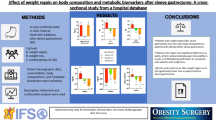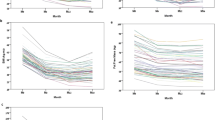Abstract
Purpose
To investigate the changes in weight, body composition, and metabolic biomarkers in patients with obesity after laparoscopic sleeve gastrectomy (LSG) and compare those changes between patients with and without metabolic syndrome (MS).
Materials and Methods
This retrospective longitudinal study included 76 patients who underwent LSG, among whom 32 had complete 1-year postoperative body composition and metabolic biomarkers. Body composition was measured by quantitative CT. Weight changes were compared between the MS and non-MS groups at 1-, 3-, 6-, and 12-month post-LSG in all patients; changes in body compositions and metabolic biomarkers from one day pre-LSG to 12-month post-LSG were also compared in those 32 patients.
Results
MS occurred in 46% (35/76) of all patients and 44% (14/32) of patients with complete follow-up data. Excess weight loss was lower in the MS group than that in the non-MS group at 1-, 3-, 6-, and 12-month post-LSG; the 12-month difference was significant (MS vs. non-MS: 0.91 ± 0.22 vs. 1.07 ± 0.42, P = 0.04). The greatest rate of visceral fat area (VFA) change occurred 12-month post-LSG in both the non-MS [0.62(0.55,0.7)] and MS [0.6(0.51,0.63)] groups. The most significant reduction in ectopic fat occurred in liver fat (LF) [non-MS, 0.45(0.22,0.58); MS, 0.39(0.23,0.58)].
Conclusion
LGS significantly improves weight, body composition, and metabolic biomarkers in populations with obesity, regardless of whether they have MS. Among the body composition, VFA and LF were the most significantly improved body composition measurements.
Graphical Abstract





Similar content being viewed by others
References
Kelly T, Yang W, Chen CS, et al. Global burden of obesity in 2005 and projections to 2030. Int J Obes (Lond). 2008;32(9):1431–7. https://doi.org/10.1038/ijo.2008.102.
Ozsoy Z, Demir E. Which bariatric procedure is the most popular in the world? A bibliometric comparison Obes Surg. 2018;28(8):2339–52. https://doi.org/10.1007/s11695-018-3163-6.
Khorgami Z, Shoar S, Andalib A, et al. Trends in utilization of bariatric surgery, 2010–2014: sleeve gastrectomy dominates. Surg ObesRelat Dis. 2017;13(5):774–8. https://doi.org/10.1016/j.soard.2017.01.031.
Neff KJ, Olbers T, le Roux CW. Bariatric surgery: the challenges with candidate selection, individualizing treatment and clinical outcomes. BMC Med. 2013;11:8. https://doi.org/10.1186/1741-7015-11-8.
Muraca E, Oltolini A, Binda A, et al. Metabolic and psychological features are associated with weight loss 12 months after sleeve gastrectomy. J Clin Endocrinol Metab. 2021;106(8):e3087–97. https://doi.org/10.1210/clinem/dgab161.
Guo L, Luo W, Tan T, et al. Early-phase insulin hypersecretion associated with weight loss outcome after LSG: a prospective cohort study in Asian patients with BMI ≥28 kg/m2. Surg Obes Relat Dis. 2022;18(10):1209–17. https://doi.org/10.1016/j.soard.2022.05.013.
Yue Z, Qian L, Jin Y, et al. Hyperinsulinemia influences the short-term efficiency of laparoscopic sleeve gastrectomy for patients with obesity and insulin resistance. Diabetes Metab Syndr Obes. 2023;16:1745–53. https://doi.org/10.2147/DMSO.S411440.
Roberts CK, Hevener AL, Barnard RJ. Metabolic syndrome and insulin resistance: underlying causes and modification by exercise training. Compr Physiol. 2013;3(1):1–58. https://doi.org/10.1002/cphy.c110062.
Al-Khyatt W, Ryall R, Leeder P, et al. Predictors of inadequate weight loss after laparoscopic gastric bypass for morbid obesity. Obes Surg. 2017;27(6):1446–52. https://doi.org/10.1007/s11695-016-2500-x.
Nielsen MS, Christensen BJ, Schmidt JB, et al. Predictors of weight loss after bariatric surgery-a cross-disciplinary approach combining physiological, social, and psychological measures. Int J Obes (Lond). 2020;44(11):2291–302. https://doi.org/10.1038/s41366-020-0576-9.
Neeland IJ, Ross R, Després JP, et al. Visceral and ectopic fat, atherosclerosis, and cardiometabolic disease: a position statement. Lancet Diabetes Endocrinol. 2019;7(9):715–25. https://doi.org/10.1016/S2213-8587(19)30084-1.
Sheu Y, Marshall LM, Holton KF, et al. Abdominal body composition measured by quantitative computed tomography and risk of non-spine fractures: the Osteoporotic Fractures in Men (MrOS) Study. Osteoporos Int. 2013;24(8):2231–41. https://doi.org/10.1007/s00198-013-2322-9.
Bakris G, Ali W, Parati G. ACC/AHA versus ESC/ESH on hypertension guidelines: JACC guideline comparison. J Am Coll Cardiol. 2019;73(23):3018–26. https://doi.org/10.1016/j.jacc.2019.03.507.
National Cholesterol Education Program (NCEP) Expert Panel on Detection, Evaluation, aToHBCiA(TP III). Third report of the National Cholesterol Education Program (NCEP) expert panel on detection, evaluation, and treatment of high blood cholesterol in adults (Adult Treatment Panel III) final report. Circulation. 2002; 106(25):3143–3421
Albanopoulos K, Tsamis D, Natoudi M, et al. The impact of laparoscopic sleeve gastrectomy on weight loss and obesity-associated comorbidities: the results of 3 years of follow-up. Surg Endosc. 2016;30(2):699–705. https://doi.org/10.1007/s00464-015-4262-2.
Sarela AI, Dexter SP, O’Kane M, et al. Long-term follow-up after laparoscopic sleeve gastrectomy: 8–9-year results. Surg ObesRelat Dis. 2012;8(6):679–84. https://doi.org/10.1016/j.soard.2011.06.020.
Golzarand M, Toolabi K, Djafarian K. Changes in body composition, dietary intake, and substrate oxidation in patients underwent laparoscopic Roux-en-Y gastric bypass and laparoscopic sleeve gastrectomy: a comparative prospective study. Obes Surg. 2019;29(2):406–13. https://doi.org/10.1007/s11695-018-3528-x.
Bray GA, Jablonski KA, Fujimoto WY, et al. Relation of central adiposity and body mass index to the development of diabetes in the Diabetes Prevention Program. Am J Clin Nutr. 2008;87(5):1212–8. https://doi.org/10.1093/ajcn/87.5.1212.
Fox CS, Massaro JM, Hoffmann U, et al. Abdominal visceral and subcutaneous adipose tissue compartments: association with metabolic risk factors in the Framingham Heart Study. Circulation. 2007;116(1):39–48. https://doi.org/10.1161/CIRCULATIONAHA.106.675355.
Marchesini G, Bugianesi E, Forlani G, et al. Nonalcoholic fatty liver, steatohepatitis, and the metabolic syndrome. Hepatology. 2003;37(4):917–23. https://doi.org/10.1053/jhep.2003.50161.
Meyer-Gerspach AC, Peterli R, Moor M, et al. Quantification of liver, subcutaneous, and visceral adipose tissues by MRI before and after bariatric surgery. Obes Surg. 2019;29(9):2795–805. https://doi.org/10.1007/s11695-019-03897-2.
Silva LB, Oliveira BMPM, Correia F. Evolution of body composition of obese patients undergoing bariatric surgery. Clin Nutr ESPEN. 2019;31:95–9. https://doi.org/10.1016/j.clnesp.2019.02.002.
Blaho M, Macháčková J, Dítě P, et al. Use of magnetic resonance imaging to quantify fat and steatosis in the pancreas in patients after bariatric surgery: a retrospective study. Obes Surg. 2022;32(11):3666–74. https://doi.org/10.1007/s11695-022-06278-4.
Galanakis CG, Daskalakis M, Manios A, et al. Computed tomography-based assessment of abdominal adiposity changes and their impact on metabolic alterations following bariatric surgery. World J Surg. 2015;39(2):417–23. https://doi.org/10.1007/s00268-014-2826-2.
Hong W, Hao X, Tao C, et al. Association between quantitative CT-measured body composition and metabolic syndrome components in obese patients before bariatric surgery. Chin J Health Manag. 2024;18(02):127–34. https://doi.org/10.3760/cma.j.cn115624-20230924-00155.
Ross R, Dagnone D, Jones PJ, et al. Reduction in obesity and related comorbid conditions after diet-induced weight loss or exercise-induced weight loss in men. A randomized, controlled trial. Ann Intern Med. 2000;133(2):92–103. https://doi.org/10.7326/0003-4819-133-2-200007180-00008.
Smith U, Kahn BB. Adipose tissue regulates insulin sensitivity: role of adipogenesis, de novo lipogenesis and novel lipids. J Intern Med. 2016;280(5):465–75. https://doi.org/10.1111/joim.12540.
Liu F, Chen S, Li X, et al. Obesity-induced hepatic steatosis is partly mediated by visceral fat accumulation in subjects with overweight/obesity: a cross-sectional study. Obes Facts. 2023;16(2):164–72. https://doi.org/10.1159/000527595.
Janssen JAMJL. Hyperinsulinemia and its pivotal role in aging, obesity, type 2 diabetes, cardiovascular disease and cancer. Int J Mol Sci. 2021;22(15):7797. https://doi.org/10.3390/ijms22157797.
Huang Z, Huang L, Waters MJ, et al. Insulin and growth hormone balance: implications for obesity. Trends Endocrinol Metab. 2020;31(9):642–54. https://doi.org/10.1016/j.tem.2020.04.005.
Author information
Authors and Affiliations
Corresponding author
Ethics declarations
Ethical Approval
All procedures performed in studies involving human participants were in accordance with the ethical standards of the institutional and/or national research committee and with the 1964 Helsinki declaration and its later amendments or comparable ethical standards. This study has been approved by the Scientific research and New technology IRB of Wannan Medical College Yijishan Hospital.
Informed Consent
Informed consent was obtained from all individual participants included in the study.
Conflict of Interest
The authors declare no competing interests.
Additional information
Publisher's Note
Springer Nature remains neutral with regard to jurisdictional claims in published maps and institutional affiliations.
Key Points
One-year post-LGS, obese patients show improvements in biochemical parameters.
One-year post-LGS, both BMI and body composition significantly decrease.
Preoperative metabolic abnormalities have minimal impact on postoperative outcomes.
QCT effectively assesses the specific distribution of fat reduction post LSG.
Rights and permissions
Springer Nature or its licensor (e.g. a society or other partner) holds exclusive rights to this article under a publishing agreement with the author(s) or other rightsholder(s); author self-archiving of the accepted manuscript version of this article is solely governed by the terms of such publishing agreement and applicable law.
About this article
Cite this article
Hong, W., Tang, W., Hao, X. et al. Short-Term Changes in Weight, Body Composition, and Metabolic Biomarkers After Laparoscopic Sleeve Gastrectomy in Patients with Obesity: A Comparative Prospective Study. OBES SURG 34, 1801–1809 (2024). https://doi.org/10.1007/s11695-024-07208-2
Received:
Revised:
Accepted:
Published:
Issue Date:
DOI: https://doi.org/10.1007/s11695-024-07208-2




